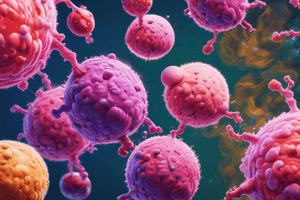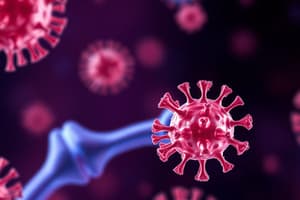Podcast
Questions and Answers
What distinguishes primary immunodeficiency from secondary immunodeficiency?
What distinguishes primary immunodeficiency from secondary immunodeficiency?
- Primary immunodeficiency affects only T cells.
- Primary immunodeficiency is not associated with any diseases.
- Primary immunodeficiency often results from environmental factors.
- Primary immunodeficiency is usually caused by a genetic defect. (correct)
Which immunodeficiency is characterized by a deficiency in helper T cells?
Which immunodeficiency is characterized by a deficiency in helper T cells?
- Chronic granulomatous disease
- Congenital agammaglobulinemia
- AIDS (correct)
- Wiskott-Aldrich syndrome
Which of the following is classified as a combined immunodeficiency?
Which of the following is classified as a combined immunodeficiency?
- X-linked agammaglobulinemia
- AIDS
- Severe combined immunodeficiency disease (correct)
- C3 deficiency
What type of immunodeficiency does C3 deficiency fall under?
What type of immunodeficiency does C3 deficiency fall under?
Which immunodeficiency condition was the first to be described in 1952?
Which immunodeficiency condition was the first to be described in 1952?
What is the genetic basis of X-linked agammaglobulinaemia (Bruton’s disease)?
What is the genetic basis of X-linked agammaglobulinaemia (Bruton’s disease)?
What are the typical presenting infections in a child with X-linked agammaglobulinaemia?
What are the typical presenting infections in a child with X-linked agammaglobulinaemia?
Which symptom is NOT commonly associated with Wiskott–Aldrich syndrome?
Which symptom is NOT commonly associated with Wiskott–Aldrich syndrome?
What is the typical treatment regimen for managing X-linked agammaglobulinaemia?
What is the typical treatment regimen for managing X-linked agammaglobulinaemia?
What type of genetic inheritance is associated with Wiskott–Aldrich syndrome?
What type of genetic inheritance is associated with Wiskott–Aldrich syndrome?
Which of the following does NOT occur in patients with X-linked agammaglobulinaemia?
Which of the following does NOT occur in patients with X-linked agammaglobulinaemia?
Which of the following infections is most commonly associated with Wiskott–Aldrich syndrome?
Which of the following infections is most commonly associated with Wiskott–Aldrich syndrome?
At what age do symptoms of X-linked agammaglobulinaemia typically present?
At what age do symptoms of X-linked agammaglobulinaemia typically present?
Which clinical feature differentiates Wiskott–Aldrich syndrome from X-linked thrombocytopenia?
Which clinical feature differentiates Wiskott–Aldrich syndrome from X-linked thrombocytopenia?
What is the location of the gene responsible for Wiskott–Aldrich syndrome?
What is the location of the gene responsible for Wiskott–Aldrich syndrome?
Flashcards
Primary Immunodeficiency
Primary Immunodeficiency
Immunodeficiency caused by a genetic defect.
Secondary Immunodeficiency
Secondary Immunodeficiency
Immunodeficiency originating from another underlying disease.
Antibody Immunodeficiency
Antibody Immunodeficiency
Deficiency affecting the B cells, impacting antibody production.
Bruton's agammaglobulinemia
Bruton's agammaglobulinemia
Signup and view all the flashcards
Severe Combined Immunodeficiency (SCID)
Severe Combined Immunodeficiency (SCID)
Signup and view all the flashcards
Bruton's disease incidence
Bruton's disease incidence
Signup and view all the flashcards
Bruton's disease cause
Bruton's disease cause
Signup and view all the flashcards
Bruton's disease symptom onset
Bruton's disease symptom onset
Signup and view all the flashcards
Bruton's disease treatment
Bruton's disease treatment
Signup and view all the flashcards
Bruton's disease diagnosis
Bruton's disease diagnosis
Signup and view all the flashcards
Wiskott-Aldrich Syndrome (WAS)
Wiskott-Aldrich Syndrome (WAS)
Signup and view all the flashcards
WAS gene location
WAS gene location
Signup and view all the flashcards
WAS presentation symptoms
WAS presentation symptoms
Signup and view all the flashcards
WAS diagnosis
WAS diagnosis
Signup and view all the flashcards
X-linked Thrombocytopenia
X-linked Thrombocytopenia
Signup and view all the flashcards
Study Notes
Immunodeficiency Conditions - Classification
- Immunodeficiencies can be categorized as primary (often genetic) or secondary (caused by another condition).
- Primary immunodeficiencies encompass those affecting the specific immune system (e.g., T cells, B cells) or the innate/nonspecific immune system (e.g., complement, neutrophils).
- Secondary immunodeficiencies are triggered by factors like viral infections (HIV, CMV, EBV), chronic infections, malignancies, therapies, drugs, radiation, and other non-immunological diseases.
- Genetic causes include autosomal recessive, autosomal dominant, and X-linked inheritance patterns. Gene deletions and rearrangements are also possible mechanisms.
- Biochemical/metabolic deficiencies include adenosine deaminase deficiency, purine nucleoside phosphorylase (PNP) deficiency, biotin-dependent multiple carboxylase deficiency, and deficient membrane glycoproteins.
- Vitamin or mineral deficiencies can also lead to immunodeficiencies (e.g., zinc, B12, biotin).
Clinical Features of Immunodeficiency: Recurrent Infections
- Recurrent infections use a flexible definition.
- Two or more major or one major and recurring minor infections within a year might suggest immunodeficiency.
- Unusual organisms (e.g., Aspergillus, Pneumocystis) could indicate immunodeficiency.
- Unusual infection sites (e.g., liver abscess, osteomyelitis) and chronic infections (e.g., sinusitis) are indicators.
- Structural damage (e.g., bronchiectasis) also suggests immunodeficiency.
Algorithm for Evaluation of Recurrent Infections
- Stage 1: general evaluation includes history, physical exam, height and weight, and exclusion of other potential causes.
- Stage 2: immunologic tests include immunoglobulin levels (IgG, IgA, IgM), IgE (if allergic symptoms are present), specific antibody responses (to tetanus, diphtheria, pneumococcal vaccines), IgG subclass analysis, lymphocyte markers (CD3/CD4/CD8), and complement screening (CH50, C3, C4).
X-linked Agammaglobulinemia (Bruton's Disease)
- This is the first recognized immunodeficiency disease.
- Genetic disorder caused by mutations in the BTK gene on the X chromosome (Xq21.3-22).
- Defects prevent B-cell maturation from pro-B to pre-B cells.
- Presents with high incidence of recurrent bacterial infections after early childhood.
- Diagnosis involves low or absent B cells and reduced IgG levels; T and NK cell counts/function are typically normal.
Wiskott-Aldrich Syndrome (WAS)
- An X-linked disorder affecting the WASP gene (Xp11.23).
- Characterized by thrombocytopenia (small platelets), eczema, and progressive immune deficiency.
- Diagnosis involves clinical features, identification of low or absent WASP, and immunological analysis.
- Immunological components like T cells, IgA, IgG, IgE may be affected.
- Symptoms include easy bruising, eczema, and recurrent infections (bacterial, fungal, viral, protozoal).
Ataxia Telangiectasia (AT)
- Autosomal recessive condition (11q22.23), affecting the ATM gene.
- Characterized by progressive cerebellar ataxia, normal intellect, typical telangiectasia (especially on ear lobes and conjunctivae), recurrent bacterial sinopulmonary infections, and an increased risk of cancer due to DNA repair defects.
- Immunological findings can include variable immunoglobulins (IgG2/IgG4, IgA, IgE reduced), reduced T cell numbers, and elevated alpha-fetoprotein (AFP).
- Presentation includes ataxia, difficulty with coordination, balance, slurred speech, and slowed eye movements.
DiGeorge Syndrome
- Results from a microdeletion of 22q11.2.
- Often presents with a triad of hypoplastic thymus, cardiac anomalies, and hypocalcemia.
- Immunological effects include possible deficiency of T cells or other immune components.
- Symptoms include heart defects and immune deficiency leading to recurrent infections. Diagnosis involves tests like cardiac echo, endocrine testing (checking calcium, phosphorus), and checking immune function (including the thymus).
Studying That Suits You
Use AI to generate personalized quizzes and flashcards to suit your learning preferences.




